Doug Croley (Havana, Florida)
Doug Croley's operation is just outside Havana (Gadsden County) Florida. Although I receive my mail through Tallahassee (Leon County) Florida, I live closer to Havana (say HAY vanna). This area has a number of unique characteristics and when details are considered contrasts rather sharply with my growing-up place (Nashville (Berrien County) Georgia), which is only about 100 miles to the northeast, emphasizing the heterogeneity of the South's agricultural development, demographics, and historic social structure. For these reasons, I want to say a very few words, which I will supplement in other posts, following the acknowledgements. The reader who is disinterested in my commentary should scroll now to the text near the first slide and pick up on Doug Croley and his friends there.
I thank Doug for bringing me into his family circle; he is a fountainhead of information about the area-his family goes back to the beginnings and indeed, he is a descendent of Dr. Malcolm Nicholson. (I should mention that I thank Doug for sponsoring an NPR program I regularly listen to too.) I also acknowledge the venerable Steve Edwards, beloved former physics professor, physics chairman, Dean of the Faculties, and Deputy Provost at Florida State. Before Florida was added to the U.S. (1821; statehood, 1845), Steve's family moved from Georgia to near Apsalaga, then the name of a landing on the east side of the Apalachicola River. (It is another story, but apparently, in an attempt to discourage Georgians, specie from Georgia was not accepted for official land purchase although money from banks from far away was.) Steve's history knowledge of this area (and of Florida State University) is encyclopedic. Finally, anyone interested in the development of this area is obliged to read Clifton Paisley's The Red Hills of Florida, 1528-1865 and can become thoroughly acquainted with sugar-cane culture in the South by reference to Sugar Country. The sugar cane industry in the South. 1753-1950. As I am not an expert and cite from memory additional sources, I would appreciate having readers correct me so that this page will not be a source of misinformation.
Originally, Gadsden County stretched from the Appalachicola to the Suwannee. (Given his spelling, Foster should have stuck with the Pee Dee, but another day . . . .) A band of land, not more than 30 miles wide in Florida, in the northern part, north of the Cody Scarp (about the location of the old B&W Fruit stand perhaps a quarter-mile south of the capitol), below which is sandy, ancient coast, and south of the Coastal Plain, more-or-less flat sandy loam, the northern boundary of which is the Fall Line, lies the unique physiographic region variously called the Tallahassee Hills or Red Hills. Instead of making an independent inadequate effort at describing this area, I defer to Judge Henry M. Backenridge's 1827 description, excerpts I copy here from Bertram Groene's book (Ante-bellum Tallahassee):
In appearance, it is entirely unlike any part of the United States, so near the seaboard yet it resembles the high land above the falls of the rivers in the Atlantic States. . . . . The largest of the lakes are called the Imonia, Jackson and Mickasuki, each from thirty to forty miles in circumference and which abound in fish, Trout, Bream, Perch and soft-shelled turtle: and in winter with Water Fowl. . . . The natural open groves of hickory, beech, oak and magnolia surpass in magnificence the proudest parks of the English nobility. . . . The soil of the uplands bears a strong resemblance to the best part of Prince George's County, Maryland; and the face of the country is not unlike the South side of the Potomac, opposite Washington City . . . . In the valleys, there is much heavier growth of timber and frequently deep cane brakes. There are also grassy ponds surrounded by glades. The soil of the uplands as well as in the valley is adapted to the culture of sugar cane, rice, Sea Island cotton and Indian Corn . . . the Strawberry, the wild grape and plum are found everywhere. . . . . The only regret that I feel in contemplating this beautiful region is its very limited extent-an oasis which appears to have been formed by nature in one of her most sportive and fantastic humors.
(Because it is unseemly, I do not mention the unspeakable cruelty of de Soto (who cut the hands off 20 braves to prove a point), the exploits of the murderous "patriot" A. Jackson (whose picture I do not carry in my wallet), the first state execution (of a Carroll, the maiden name of my ggrandmother Outlaw, unless you count an Indian who starved himself to death in the Tallahassee jail), that Lafayette (the middle name of my mother's senior brother, indicating my grandmother's French blood, as did my grandmother's maiden name, Fountain (from de la Fountaine)) never bothered to come look at his land, or even little things like the loss of Prince Achille Murat's finger in a duel out here at Iamonia (this Murat was the nephew of Napoleon; his wife, Catherine, was the some-times removed niece of Geo. Washington, and Catherine's Tallahassee home, Bellevue (a permanent display at the Junior Museum), is in outline ours).
Such an attractive area, notwithstanding the young-to western civilization-undisciplined Tallahassee, did attract settlers, and by 1845 Quincy, the county seat of Gadsden, was the second largest town in Florida. In the end, Gadsden was split up, with the proximate northern lands east of the Ochlockonee becoming Leon County, which, as mentioned, is where I now hold court. My hometown (incorporated 1892), the county seat of Berrien County, which was cut out of Coffee, Irwin and Lowndes Counties (1856), was an inn on Coffee Road (financed in 1823) that ran from the river at Jacksonville (Georgia) to Tallahassee.) This land (75-mile strip from the Chattahoochee to the settled counties to the east) was opened up for settlement because of Jackson's unofficial Indian war (1814-1818 time period), but part of this land was not such an attractive spoil. When planning what became the Coffee Road, some Georgia legislators opposed "spending the State's money trying to develop a country which God Almighty had left in an unfinished condition" (from MacIntyre's History of Thomas County). Unlike the Tallahassee Hills, Berrien County, therefore, hardly had an auspicious beginning.
Sugar cane has been grown at least intermittently in the Red Hills as a minor crop since at least 1770, perhaps earlier. As soon as the Anglo-settlers moved into Gadsden County, they were afflicted by "sugar fever," as related to us in Sitterson's peerless book, which is quoted extensively here. But, for a number of reasons (inexperience with cane culture, the Indian wars in the late 1830s, frost-such as that which laid waste to a large sugar-cane planting down the road from me at Lake Jackson in 1829, labor shortage, and especially, the higher value of other crops), the obsession with sugar cane subsided and cotton picked up. As perspective, a single planter in Louisiana, John Burnside, made 3,336,000 pounds of sugar in 1860 whereas the whole state of Florida produced only 1,669,000 pounds in 1859. Indeed, the total sugar production of Florida, Alabama, Texas, Georgia, South Carolina amounted to only 3.5% of that of Louisiana. Cane culture for producing sugar was won by Louisiana. Cotton became the crop in the Tallahassee Hills, although there were other crops such as tobacco, especially in Gadsden County, which I will bring up later.
By the end of the antebellum period, sugar-cane culture in South Georgia and North Florida changed faces, and generally became an industry for the more modest farmer. These farmers used family labor, small horse-drawn mills, and small kettles, and they made enough brown sugar for themselves and perhaps some to sell locally. In Georgia, sugar cane moved off the coast and to the interior (to the area of Baker, Thomas, and Lowndes Counties) just above the Florida line. In Florida, sugar-cane production was limited mostly to the Red Hills, to north central Florida (Alachua County and thereabout) and near Tampa.
The census records taken in the run-up to the war shed light on the different labor systems used in my home county and in Gadsden County. The free populations were similar (3981 in Gadsden and 3041 in Berrien), but the ratio of slave:free was vastly different (1.35:1 in Gadsden and 0.14:1 in Berrien). Gadsden County had a large number of wealthy planters (36 made more than 50 bales of cotton in 1860 and seven owned more than 70 slaves each). What was true in Gadsden was also true throughout the Red Hills. For example, Francis Eppes of Leon County (slave:free ratio of nearly 3:1) owned 69 slaves, but he is best remembered as the grandson of T. Jefferson and as a founder of the Seminary West of the Suwannee (in Tallahassee), which became, about 100 years later, the Florida State University. In an ironic way, the lack of wealth in Berrien County provided some protection against being a slave owner. From a personal perspective, the War-era ancestors of three of my four grandparents were from Berrien County and none, to my knowledge, owned another person. These yeomen produced large families, worked hard, and died young.
Although it is jumping ahead a bit, the War reversed fortunes for landowners. Down on the large plantation, the slave-labor force was gone; down on the small yeoman plantation, a generation of men had been decimated by disease and Northern armaments. What the northern armies did not kill, loot or burn was left for their civilian comrades to exploit. It took about 50 years for the tax rolls to recover. What is done is done, and there is plenty of blame to go around. In any case, Gandhi was wise ("An eye for eye only ends up making the whole world blind.") and slavery, fortunately, was no longer legally sanctioned in the U.S. (But, in 2002, three men working out of Immokalee (Florida) were convicted and sentenced for trafficking in slaves and other crimes related to farm labor.) In Gadsden County, by the 1930s, syrup production seemed to be more common in the Gretna/Sawdust/Greensboro/Flat Creek region than in other parts, according to Steve. In Berrien County at that time, syrup production was widespread, as I judge from the distribution of mills and syrup sheds yet. In another post, I will start about here and with syrup production, which, of course, is the main thing.
Two history-changing events converged in Gadsden County in the 1820s that would set it apart from most places. Shade-tobacco seeds from Cuba and Virginia planters, notably John Smith, familiar with tobacco culture arrived. Legend indicates that John Smith's settling in Gadsden was a fluke-his wagon broke down on the way to his destination, Marion County, Florida. Shade tobacco is very specific and was only grown in two places in the U.S., in the Red Hills area (and mostly Gadsden County) and in Connecticut, the latter being unimportant to us. This tobacco must be thin and without blemish because it serves as cigar wrappers. At first, it was grown under live oak trees, but later, shade was provided large slat structures, which in turn were replaced by cheesecloth. Shade tobacco was grown by large planters and small farmers alike, but especially among the latter. As relevant examples here, Doug's ancestors, Angus and Archibald Nicholson, made cigars before the War near the site of the Nicholson Farm House west of Havana (traditionally thought to be named after the city in Cuba). Culture of shade tobacco is a labor-intensive endeavor, and long after the War, much of the work still fell to African-Americans. Back in the 1930s, every hand was needed, so both Black and White schools ended in May. Later, near the end of segregated times, Black schools ended the year on May 20th (ironically, the day the Emancipation Proclamation was read in Tallahassee) so that the Black youth could work the harvest, which extended until July 4th, whereas White schools then continued until June. (An analogous situation existed in Johnson County (Georgia) where Black schools started late so the Black youth could pick cotton.) There were other crops in addition to cotton and shade tobacco, but space doesn't permit discussion. In any case, Gadsden County shade-tobacco farming was exported in the 1970s or so to Central America, where the labor was cheaper, but innovations in "artificial" wrapper production also spelled the end. But, while shade tobacco was in its prime, it generated wealth the fall-out of which remains to this day. In brief, a young start-up found receptive ears in Quincy because many citizens literally had more money that they knew to do with, and a banker, Mr. Munroe, talked up the new company. The growth in the start-up's stock (Coca Cola) left Quincy to claim more millionaires per capita than any other municipality. Whether this claim ever had merit or not doesn't change the fact that shade tobacco was an important crop.
Tobacco was and continues to be a major crop in Berrien County, but it arrived much later than in Gadsden County. In contrast to the situation there, the type in Berrien County was flue-cured and it was grown as a family endeavor, generally by landed farmers. In the 1950s and before, commonly, one family would crop tobacco one day each week, another family, another day, and so forth. Since harvest required enough hands (say, 4 croppers (usually men in their prime), 4 stringers (usually women), 8 handers (usually children), 1 sled boy, and 1 barnman (who temporarily hung the sticks on lower tiers) to fill a barn and start the week-long process of curing, neighbors would "swap" labor. On their barn-filling day, the farmer's wife or sometimes mother would cook what my father called with a hint of disdain a "log-rolling dinner." It would have been an insufferable humiliation to run out of any of the meat dishes (always fried chicken, fried pork chops, and then one or two more), vegetables, desserts, and so forth, all of which was washed down with gallons of syrupy sweet iced tea. All of this ran the course of about 7 weeks as newly senescing leaves were harvested from the bottom of the plant, a few each week. Then, came the excitement of selling tobacco at auction, the one month each year that there was any money in town. So, each August, the banks got paid, land mortgages were brought up to date, new vehicles were purchased, back-to-school clothes were bought, and, in the case of tenant farmers, new deals were cut for the next year. The tenant farmers, almost always White, had a social status that was marginally less than that of the landed farmer. An ordinary deal for tenant farming was to farm on halves-the landowner and tenant would split the sale price and the landowner would provide land, soil amendments and permanent equipment (barns, beds) whereas the tenant would provide labor and miscellaneous equipment.
The remainder of this narrative moves to the here-and-now with the proper focus on syrupmaking. A large tract of land between Havana and Quincy was owned by Doug's great-uncle Troy Angus Nicholson, a bachelor farmer. In the 1930s, he constructed a small tenant house on the property for a cook, "Stub" Cunningham. When B & K Farms, Inc. (operated by Doug's father-in-law, William L. ("Bill") Montague) bought the property in 1965, the tenant house found use as a place to pack fertile eggs. Under the name of Gulf Coast Hatchery, Inc., Mr. Bill sold millions of laying chicks each year. As time went by, Hurricane Kate (1985) damaged the tenant house. A few years later it fell to Dianne Montague-Croley, Doug's spouse, to convince Mr. Bill to allow Doug and his cousin Paul Nicholson to renovate it for a hunting camp they called Little River Hunt Club. (If I am an example, a father has no defenses against a daughter's wishes.) The name "hunt club" is now a bit misleading since the hunt camp became a local area recreational gathering place for friends and family, especially since Paul Nicholson's death in 1999.
_(93)_Grinding_overview-Lee_Avirett-Doug-Shine-t.jpg) As
a means of preserving traditions and passing them on to youth, Doug and his
friends set up a sugar-cane operation in 2002, and this page
recounts their first season's success. The Hunt Club so-called is an egalitarian
outfit, but no one puts more of his heart into the operation that does Doug Croley
(right), shown with Lee Averitt (a cousin, sharing an ancestor,
Mrs. Malcolm
Nicholson) and the mule Shine (one of two pet mules belonging to Jim and Sharon
Bennett, who own and operate Jim Bennett's Plumbing in Tallahassee). This early-shot
was taken before the morning had cleared, and never have I seen a more beautiful site
than the fog-shrouded Ochlockonee River, noticed as
I crossed this boundary between Leon County and Gadsden County.
As
a means of preserving traditions and passing them on to youth, Doug and his
friends set up a sugar-cane operation in 2002, and this page
recounts their first season's success. The Hunt Club so-called is an egalitarian
outfit, but no one puts more of his heart into the operation that does Doug Croley
(right), shown with Lee Averitt (a cousin, sharing an ancestor,
Mrs. Malcolm
Nicholson) and the mule Shine (one of two pet mules belonging to Jim and Sharon
Bennett, who own and operate Jim Bennett's Plumbing in Tallahassee). This early-shot
was taken before the morning had cleared, and never have I seen a more beautiful site
than the fog-shrouded Ochlockonee River, noticed as
I crossed this boundary between Leon County and Gadsden County.
Will Croley (Slide 2), the son of Doug's brother, Johnny, feeds a Chattanooga No. 14. This large two-horse mill was advertised as being able to extract 1000 gallons of juice a day. Earlier, Johnny was in the tomato business and if you live on the eastern seaboard, you have probably eaten one of his tomatoes. John Hilton Revell, related through his mother to Doug, is shown in Slide 3, whereas Bill Smith and Rev. Humphrey Kanga (from Kenya and a guest of Dickson Lester, related to Doug on the Avirett side) are shown in Slide 4. Being an animal lover, I also show Millie, the other of the Bennett mules who worked that day (Slide 5).
The cane came of three sources (IFAS, a purple cane from Medart (Florida), and Yellow Gal (C.P 29-116) from Tommy Lackey (Gainey Crossroads, Grady County, Georgia)). Doug applied two handfuls of cottonseed meal to each stool in May and July. About September 1, he applied a generous amount of potash. I mention the culture because the cane was excellent and it came back from the stubble well.
Scrapers and journal lids are the two parts of a cane mill that are most likely missing in my experience. The lids are not really necessary, but the scrapers are. An ingenious set of scrapers was attached to the Chattanooga mill, as shown (Slide 6). The scrapers were fixed to frame bolts by a slotted arm to permit adjustment.
The syrup shed (Slide 7) is set off from the lodge and the mill. Doug obtained a 60-gallon Crockett kettle (Slide 8, cast in Macon (Georgia)), along with the mill, from Kyle Fuller of Fitzgerald (Georgia), less than an hour from my hometown, but not one to which visits were encouraged by my family for obvious reasons. This style of kettle, as mentioned elsewhere, was called a salt kettle and in addition to the purposes stated, Doug mentioned that its thick walls (estimated weight=450 lbs.) facilitated rice preparation on a large scale for a labor force. To permit a side-by-side comparison, I show an upturned Chattanooga kettle (Slide 9).
_(68)_Furnace_door-t.jpg) Eddie Nix (left,
one of the world's nice people and Doug's first cousin on Doug's father's side) and Roy Allen strain the juice again as it is poured into the
kettle (Slide 10). Eddie was one of the main syrupmakers (Slide
11) and is shown by the beautiful furnace that features an antique door from a
tobacco-barn furnace (Slide
12).
Eddie Nix (left,
one of the world's nice people and Doug's first cousin on Doug's father's side) and Roy Allen strain the juice again as it is poured into the
kettle (Slide 10). Eddie was one of the main syrupmakers (Slide
11) and is shown by the beautiful furnace that features an antique door from a
tobacco-barn furnace (Slide
12).
Linda Polk and her husband, Jack (not shown), are commercial beekeepers who are blessed to live in tupelo country. She and her grandson are shown bottling the first batch of syrup (Slide 13). Mr. Ed Bates (Slide 14, another great guy) was the master of the mullet fryer. Without belaboring details, I have eaten a lot of mullet, but only his were as good as my Aunt Bessie's and my mother's. Enough said. On the second day of syrupmaking, Dianne and friends prepared ham and other traditional southern favorites, some on a 50-gallon Kehoe kettle that was used as a fire pit (Slide 15).
In summary, thanks again to Doug (Slide 16, shown with his mother) for making the case again that syrupmaking is more than the sum of antique equipment, plant culture, and cooking.
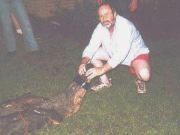
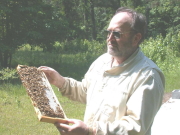
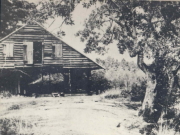
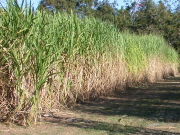
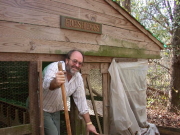
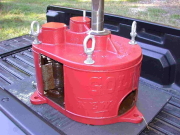
_(20)_Will_Croley-t.jpg)
_(96)_Feeding_mill-Bill_Smith-visitor_from_Kenya-t.jpg)
_(88)_Millie-t.jpg)
_(88)_scrapers_on_Chatt_14-t.jpg)
_(87)_Syrup_shed_Bill_Smith-Dick_Avirett-Ed_Bates-t.jpg)
_(87)_Crockett_kettle-t.jpg)
_(87)_60_gallon_Chattanooga-t.jpg)
_(66)_Ed_Nix_&_Roy_Allen_pouring_juice-t.jpg)
_(52)_Ed_Nix_skimming-t.jpg)
_(89)_Mrs._Polk_&_grandson%20_bottling-t.jpg)
_(94)_Mr._Bates_cooking_mullet-t.jpg)
_(87)_fire_pit-Kehoe_50-t.jpg)
_(90)_Doug_&_Mom_Mary-t.jpg)